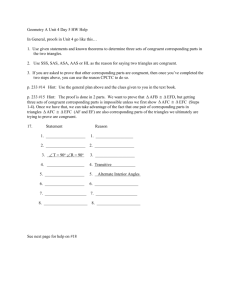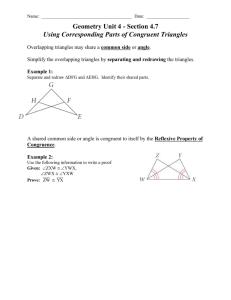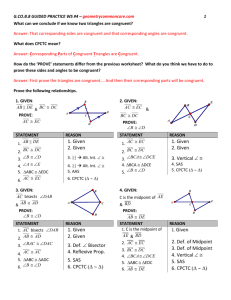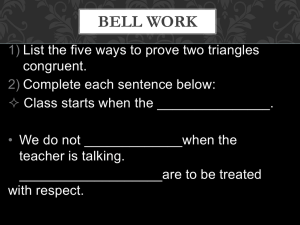HL Theorem & CPCTC Geometry Lesson Plan
advertisement
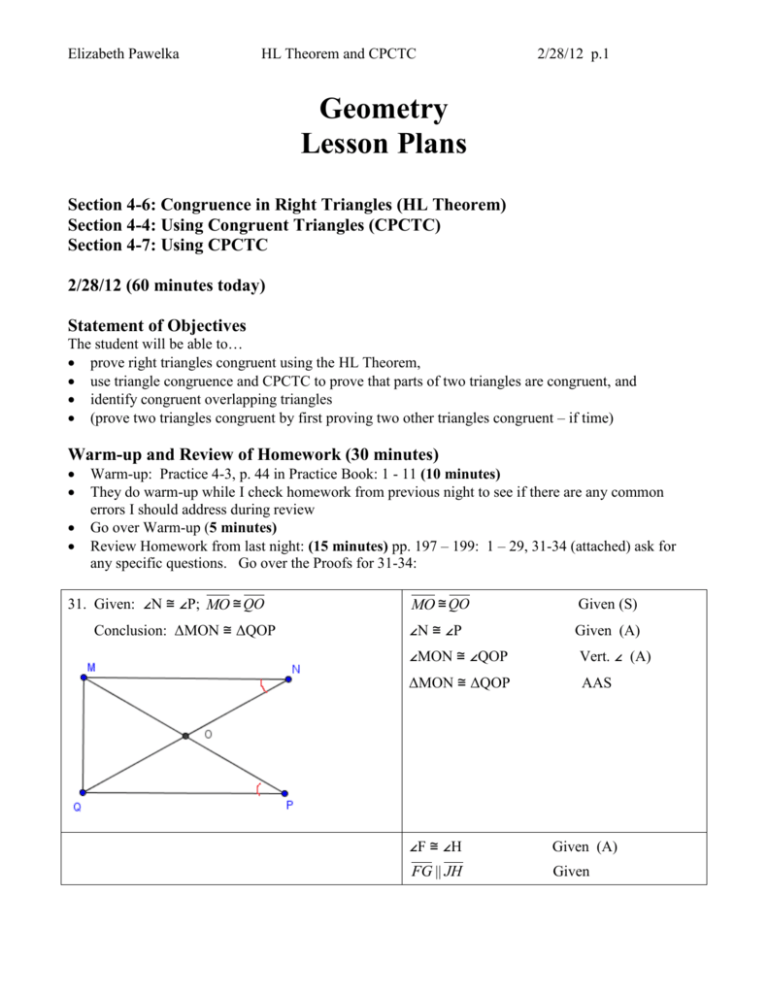
Elizabeth Pawelka HL Theorem and CPCTC 2/28/12 p.1 Geometry Lesson Plans Section 4-6: Congruence in Right Triangles (HL Theorem) Section 4-4: Using Congruent Triangles (CPCTC) Section 4-7: Using CPCTC 2/28/12 (60 minutes today) Statement of Objectives The student will be able to… prove right triangles congruent using the HL Theorem, use triangle congruence and CPCTC to prove that parts of two triangles are congruent, and identify congruent overlapping triangles (prove two triangles congruent by first proving two other triangles congruent – if time) Warm-up and Review of Homework (30 minutes) Warm-up: Practice 4-3, p. 44 in Practice Book: 1 - 11 (10 minutes) They do warm-up while I check homework from previous night to see if there are any common errors I should address during review Go over Warm-up (5 minutes) Review Homework from last night: (15 minutes) pp. 197 – 199: 1 – 29, 31-34 (attached) ask for any specific questions. Go over the Proofs for 31-34: 31. Given: ∠N ≅ ∠P; MO ≅ QO Conclusion: ΔMON ≅ ΔQOP MO ≅ QO Given (S) ∠N ≅ ∠P Given (A) ∠MON ≅ ∠QOP Vert. ∠ (A) ΔMON ≅ ΔQOP AAS ∠F ≅ ∠H Given (A) FG || JH Given Elizabeth Pawelka HL Theorem and CPCTC 32. Given: ∠F ≅ ∠H; FG || JH Conclusion: ΔFGJ ≅ ΔHJG 33. Given: AE || BD ; AE ≅ BD ; ∠E ≅ ∠D Conclusion: ΔAEB ≅ ΔBDC 34. Given: DH bisects ∠BDF; ∠1 ≅ ∠2 Conclusion: ΔBDH ≅ ΔFDH 2/28/12 p.2 ∠FGJ ≅ ∠HJG AIA (A) GJ ≅ JG Reflexive (S) ΔFGJ ≅ ΔHJG AAS ∠E ≅ ∠D Given (A) AE ≅ BD Given (S) AE || BD Given ∠EAB ≅ ∠DBC Corresponding ∠’s (A) ΔAEB ≅ ΔBDC ASA ∠1 ≅ ∠2 Given (A) DH ≅ DH Reflexive (S) DH bisects ∠BDF Given ∠BDH ≅ ∠FDH Def of angle bisector (A) ΔBDH ≅ ΔFDH ASA Elizabeth Pawelka HL Theorem and CPCTC 2/28/12 p.3 Teacher Input (25 minutes) Section 4-6: HL Theorem Activity (5 minutes) – if time allows Introduce HL Theorem with the Geogebra file Sec4-6-HL.ggb. It has two right triangles whose lengths can be changed. Show that, if one pair of legs and the hypotenuses have the same length, the other legs will be the same, too, giving SSS congruence. There may be some cases in which it doesn’t quite match up at first, but explain that is due to rounding considerations. Also point out that this is a special case of SSA for right angles only. Lecture/Examples: (10 minutes) Review vocabulary hypotenuse and legs of right triangles. Show example: Hypotenuse: longest side and across from right angle Legs: the other two sides Introduce the Hypotenuse-Leg Theorem on same slide: “If the hypotenuse and a leg of one right triangle are congruent to the hypotenuse and a leg of another right triangle, then the two triangles are congruent.” HL Theorem cont’d Point out that while this looks like SSA it is ONLY for right triangles. Explain that the sides of a right triangle have a definite relationship due to the Pythagorean Theorem and that is why we know that if two sides are congruent, then the third side also is. Example 1: HL Theorem Elizabeth Pawelka HL Theorem and CPCTC 2/28/12 p.4 Given: ∠P and ∠R are right angles PS ≅ RQ Prove: ΔPQS ≅ ΔRSQ Point out you have to always show they are right triangles AND H and L are congruent. ∠P and ∠R are right angles: Given ΔPQS & ΔRSQ are right triangles: Def of right triangles QS = SQ (Hypotenuse) Reflexive Prop PS ≅ RQ (Leg) Given ΔPQS ≅ ΔRSQ HL Thm Example 2: HL Theorem Given: MJ ┴ NK MN ≅ MK Prove: ΔMJN ≅ ΔMJK MJ ┴ NK Given ∠MJN and ∠MJK are right angles Def of perpendicular ΔMJN and ΔMJK are right Δ’s Def of right Δ’s MN ≅ MK (H) Given MJ = MJ (L) Reflexive Prop Flow Proof for slide: e ___________ ΔPQS ≅ ΔRSQ HL Theorem Elizabeth Pawelka HL Theorem and CPCTC 2/28/12 p.5 e ______________ e ______________ e ______________ e ___________ e ______________ Section 4-4/4-7: CPCTC Lecture/Examples (15 minutes) Section 4-4 and 4-7 Review: 4) CA=JS; AT=SD; CT=JD 5) ∠C≅∠J; ∠A≅∠S; ∠T≅∠D 6) WX=JK; XY=KL; YZ=LM; WZ=JM 7) ∠W≅∠J; ∠X≅∠K; ∠Y≅∠L; ∠Z≅∠M Introduce CPCTC definition: Once you have congruent triangles, you can make conclusions about other parts of the triangles because, by definition, Corresponding Parts of Congruent Triangles are Congruent (CPCTC) Elizabeth Pawelka HL Theorem and CPCTC 2/28/12 p.6 Example 3: Real-life example: Using CPCTC to measure distances (Note this is in the textbook on p. 204 if there is not time to go into this.) Tell story of Napoleon’s officer measured the width of a river using CPCTC. “He used his vision and set his visor so the farthest thing he could see was the edge of opposite bank. Then he turned down the river to note the farthest spot he could see on the bank and declared that distance the width of the river. Was he right? Let’s prove it” Show the picture and Statements and fill in the Reasons together. CPCTC Notes – emphasize these ideas as a difference in CPCTC proofs Watch for what you are being asked to prove! CPCTC proofs are asking for parts to be congruent as the final statement, not the triangles. BUT, you have to prove the triangles are congruent first. Example 4: Go over it with them – point out to look for what you are trying to prove and that CPCTC proofs aren’t looking for triangle congruence as the final statement. You have to prove triangles are congruent to prove a segment or angle congruency. Example 5: They fill in blanks Elizabeth Pawelka a) HL Theorem and CPCTC ; b) Def of angle bisector; c) QB=QB; d) SAS; e) CPCTC Example 6: Overlapping Triangles (be sure to exaggerate what the triangles are) Given: Prove: Statements 1. 2. 3. 4. 2/28/12 p.7 Reasons 1. Given 2. Given (S) (A) 3. Reflexive Property of ≅ (S) 4. SAS Example 7: Overlapping Triangles: They help me fill it in. Prove: ΔACD ≅ ΔECB Statements Statements 1. AB = ED, 2. BC = DC 3. ∠C ≅ ∠C 4. AB+BC = ED+DC 5. AC = EC Reasons Given Given Reasons (S) Reflexive (A) Segment Addition Postulate Substitution (S) Elizabeth Pawelka 6. ΔACD ≅ ΔECB HL Theorem and CPCTC 2/28/12 p.8 SAS The next two examples can be used if there is time to also teach how to use two congruent triangles to prove two other triangles are congruent: Example 8: Overlapping Triangles (be sure to exaggerate what the triangles are) Sometimes you can prove one pair of triangles congruent and then use corresponding parts of those triangles to prove another pair congruent. Given: (proven in Example 6) Statements 1. Reasons 1. Given 2. Given 3. CPCTC 4. CPCTC 5. SAS 2. 3. 4. 5. Example 9: Overlapping Triangles: They help me fill it in. ΔACD ≅ ΔECB (proved in Example 7) Statements Statements Reasons ____________ Reasons 1. ΔACD (blue) ≅ ΔECB (green) Given (previously proven) 2. ∠A ≅ ∠E CPCTC (A) (S) (A) (S) Elizabeth Pawelka HL Theorem and CPCTC 3. ∠AFB ≅ ∠EFD 4. AB = ED 5. Vertical angles Given AAS 2/28/12 p.9 (A) (S) Closure (5 minutes) Today we learned to prove right triangles congruent using the HL Theorem, use triangle congruence and CPCTC to prove that parts of two triangles are congruent, identify congruent overlapping triangles, and (prove two triangles congruent by first proving two other triangles congruent – if time) Tomorrow we’ll learn how to use and apply properties of isosceles and equilateral triangles Homework pp. 219-220: 1-8, 11, 12, 16, 17, 19, 20, 28 pp. 205-207: 7-17, 19, 23 pp. 227: 10, 11
